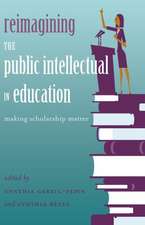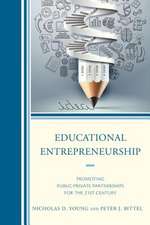Saving Our Students, Saving Our Schools: 50 Proven Strategies for Helping Underachieving Students and Improving Schools
Editat de Robert Dale Barr, William H. Parretten Limba Engleză Paperback – 4 dec 2007
Vezi toate premiile Carte premiată
IndieFab awards (2008)
Preț: 386.44 lei
Nou
Puncte Express: 580
Preț estimativ în valută:
73.94€ • 77.20$ • 61.20£
73.94€ • 77.20$ • 61.20£
Carte tipărită la comandă
Livrare economică 04-18 aprilie
Preluare comenzi: 021 569.72.76
Specificații
ISBN-13: 9781412957939
ISBN-10: 1412957931
Pagini: 432
Dimensiuni: 178 x 254 x 26 mm
Greutate: 0.85 kg
Ediția:Second Edition
Editura: SAGE Publications
Colecția Corwin
Locul publicării:Thousand Oaks, United States
ISBN-10: 1412957931
Pagini: 432
Dimensiuni: 178 x 254 x 26 mm
Greutate: 0.85 kg
Ediția:Second Edition
Editura: SAGE Publications
Colecția Corwin
Locul publicării:Thousand Oaks, United States
Recenzii
Praise for the first edition: "Barr and Parrett have provided educators, policy makers, and parents with an outstanding resource. If you’re serious about leaving no child behind, this is one book you need to read."
"I always knew that all students could meet or exceed standards if we articulated the research-based practices that worked. This is exactly what the authors have done. We now have the tools to ensure all our students are successful—what a glorious time for schools, thanks to Robert Barr and William Parrett!"
“Lives up to its title with 50 experience-tested recommendations. Though especially recommended for educators serving in America’s most troubled schools, this book is filled cover to cover with tips, tricks, techniques, and recommendations that even those most successful schools will find useful.”
"I always knew that all students could meet or exceed standards if we articulated the research-based practices that worked. This is exactly what the authors have done. We now have the tools to ensure all our students are successful—what a glorious time for schools, thanks to Robert Barr and William Parrett!"
“Lives up to its title with 50 experience-tested recommendations. Though especially recommended for educators serving in America’s most troubled schools, this book is filled cover to cover with tips, tricks, techniques, and recommendations that even those most successful schools will find useful.”
Cuprins
Preface
Acknowledgments
About the Authors
Part I. Accept the Challenge to Teach All Students
1. Confront the Challenges
Our Schools Have Changed
Who Are the At-Risk Students?
Compelling Conclusions
2. How Schools Fail Students and Manufacture Low Performance
Destructive School Policies, Programs, and Practices
The Myths That Perpetuate Ineffective Practices
3. Establish the Commitment to Educate Children and Youth at Risk
Take a Stand
Lessons Learned
Low-Performing Schools Can Improve
Part II. 50 Proven Strategies for Schools and Classrooms
4. Understand the At-Risk Student
Unconventional Wisdom: What Works for Experienced Teachers
Strategy #1: Recognize That Any Student May Become At Risk
Strategy #2: Predict Youth Behavior Based on Developmental Assets
Strategy #3: Appreciate the Resilient Student
Strategy #4: Address the Differences Between Boys and Girls
5. Educate Poor and Culturally Diverse Students
Unconventional Wisdom: What Works for Experienced Teachers
Strategy #5: Connect Culturally for Effective Teaching and Learning
Strategy #6: Work With the Externally Centered Student
Strategy #7: Understand the Problems of Low-Income Students
Strategy #8: Eliminate Ineffective and Destructive Interventions
Strategy #9: Use Effective Programs for Teaching Low-Income Students
6. Establish Priorities That Focus on Student Learning
Unconventional Wisdom: What Works for Experienced Teachers
Strategy #10: Develop a Comprehensive Plan
Strategy #11: Build a Profile by Collecting and Using Data
Strategy #12: Set Goals, Targets, and Timelines
Strategy #13: Create Time for Collaboration, Planning, and Development
Strategy #14: Facilitate Continuous Improvement: The Critical Importance of Results-Driven Leadership
7. Collaborate With Parents and Families
Unconventional Wisdom: What Works for Experienced Teachers
Strategy #15: Encourage Parent and Family Engagement
Strategy #16: Build Effective Partnerships Among Families, Schools, and the Community
8. Create Caring Classrooms, Schools, and Communities of Support
Unconventional Wisdom: What Works for Experienced Teachers
Strategy #17: Create a Community of Support
Strategy #18: Create a Common Vision
Strategy #19: Establish Alternative Schools
Strategy #20: Develop Small Schools and Schools-Within-Schools
Strategy #21: Provide Effective Transitions
9. Create a Climate of Respect in Schools and Classrooms
Unconventional Wisdom: What Works for Experienced Teachers
Strategy #22: Recognize Early Warning Signs
Strategy #23: Bully-Proof Classrooms and Schools
Strategy #24: Create Reentry Opportunities for Expelled Students
10. Expect High Academic Performance
Unconventional Wisdom: What Works for Experienced Teachers
Strategy #25: Motivate Students
Strategy #26: Teach to Multiple Intelligences
Strategy #27: Confront Tracking and Retention Practices
Strategy #28: Initiate Targeted Professional Development
Strategy #29: Create Career-Theme Schools and High School Academic Majors
Strategy #30: Help At-Risk Students Pass High-Stakes Tests
11. Teach All Students to Read
Unconventional Wisdom: What Works for Experienced Teachers
Strategy #31: Guarantee That Every Child Learns to Read
Strategy #32: Implement Effective Literacy Practices and Programs K-12
Strategy #33: Employ One-on-One Tutoring
Strategy #34: Start Early
Strategy #35: Redesign Grades K-3
Strategy #36: Continuously Assess Reading Progress
12. Select Results-Driven Instructional and Assessment Practices
Unconventional Wisdom: What Works for Experienced Teachers
Strategy #37: Personalize Instruction
Strategy #38: Recognize the Critical Importance of an Aligned Curriculum
Strategy #39: Select Research-Based Instructional Practices
Strategy #40: Use Homework Effectively
Strategy #41: Require Student Portfolios, Projects, and Performance Exhibitions
Strategy #42: Incorporate Technology Across the Curriculum
Strategy #43: Create Assessment-Literate Classrooms
13. Support Social and Emotional Growth
Unconventional Wisdom: What Works for Experienced Teachers
Strategy #44: Create Student Mentoring Programs
Strategy #45: Establish Service Learning Programs
Strategy #46: Teach Peer Mediation
Strategy #47: Build Self-Esteem and Respect Through Student Leadership
14. Use Community Resources and Services
Unconventional Wisdom: What Works for Experienced Teachers
Strategy #48: Embrace the Community as a Classroom
Strategy #49: Develop Communitywide, Extended-Day Programs
Strategy #50: Become a Full-Service School
Part III. Summon the Will to Leave No Child Behind
15. The Inalienable Right to a Quality Education
With Liberty and Justice for Some?
The Emergent National Consensus: No Child Left Behind
Breaking Free From Ignorance
The Fifty Strategies
50 Strategies Suggested Reading
References
Index
Acknowledgments
About the Authors
Part I. Accept the Challenge to Teach All Students
1. Confront the Challenges
Our Schools Have Changed
Who Are the At-Risk Students?
Compelling Conclusions
2. How Schools Fail Students and Manufacture Low Performance
Destructive School Policies, Programs, and Practices
The Myths That Perpetuate Ineffective Practices
3. Establish the Commitment to Educate Children and Youth at Risk
Take a Stand
Lessons Learned
Low-Performing Schools Can Improve
Part II. 50 Proven Strategies for Schools and Classrooms
4. Understand the At-Risk Student
Unconventional Wisdom: What Works for Experienced Teachers
Strategy #1: Recognize That Any Student May Become At Risk
Strategy #2: Predict Youth Behavior Based on Developmental Assets
Strategy #3: Appreciate the Resilient Student
Strategy #4: Address the Differences Between Boys and Girls
5. Educate Poor and Culturally Diverse Students
Unconventional Wisdom: What Works for Experienced Teachers
Strategy #5: Connect Culturally for Effective Teaching and Learning
Strategy #6: Work With the Externally Centered Student
Strategy #7: Understand the Problems of Low-Income Students
Strategy #8: Eliminate Ineffective and Destructive Interventions
Strategy #9: Use Effective Programs for Teaching Low-Income Students
6. Establish Priorities That Focus on Student Learning
Unconventional Wisdom: What Works for Experienced Teachers
Strategy #10: Develop a Comprehensive Plan
Strategy #11: Build a Profile by Collecting and Using Data
Strategy #12: Set Goals, Targets, and Timelines
Strategy #13: Create Time for Collaboration, Planning, and Development
Strategy #14: Facilitate Continuous Improvement: The Critical Importance of Results-Driven Leadership
7. Collaborate With Parents and Families
Unconventional Wisdom: What Works for Experienced Teachers
Strategy #15: Encourage Parent and Family Engagement
Strategy #16: Build Effective Partnerships Among Families, Schools, and the Community
8. Create Caring Classrooms, Schools, and Communities of Support
Unconventional Wisdom: What Works for Experienced Teachers
Strategy #17: Create a Community of Support
Strategy #18: Create a Common Vision
Strategy #19: Establish Alternative Schools
Strategy #20: Develop Small Schools and Schools-Within-Schools
Strategy #21: Provide Effective Transitions
9. Create a Climate of Respect in Schools and Classrooms
Unconventional Wisdom: What Works for Experienced Teachers
Strategy #22: Recognize Early Warning Signs
Strategy #23: Bully-Proof Classrooms and Schools
Strategy #24: Create Reentry Opportunities for Expelled Students
10. Expect High Academic Performance
Unconventional Wisdom: What Works for Experienced Teachers
Strategy #25: Motivate Students
Strategy #26: Teach to Multiple Intelligences
Strategy #27: Confront Tracking and Retention Practices
Strategy #28: Initiate Targeted Professional Development
Strategy #29: Create Career-Theme Schools and High School Academic Majors
Strategy #30: Help At-Risk Students Pass High-Stakes Tests
11. Teach All Students to Read
Unconventional Wisdom: What Works for Experienced Teachers
Strategy #31: Guarantee That Every Child Learns to Read
Strategy #32: Implement Effective Literacy Practices and Programs K-12
Strategy #33: Employ One-on-One Tutoring
Strategy #34: Start Early
Strategy #35: Redesign Grades K-3
Strategy #36: Continuously Assess Reading Progress
12. Select Results-Driven Instructional and Assessment Practices
Unconventional Wisdom: What Works for Experienced Teachers
Strategy #37: Personalize Instruction
Strategy #38: Recognize the Critical Importance of an Aligned Curriculum
Strategy #39: Select Research-Based Instructional Practices
Strategy #40: Use Homework Effectively
Strategy #41: Require Student Portfolios, Projects, and Performance Exhibitions
Strategy #42: Incorporate Technology Across the Curriculum
Strategy #43: Create Assessment-Literate Classrooms
13. Support Social and Emotional Growth
Unconventional Wisdom: What Works for Experienced Teachers
Strategy #44: Create Student Mentoring Programs
Strategy #45: Establish Service Learning Programs
Strategy #46: Teach Peer Mediation
Strategy #47: Build Self-Esteem and Respect Through Student Leadership
14. Use Community Resources and Services
Unconventional Wisdom: What Works for Experienced Teachers
Strategy #48: Embrace the Community as a Classroom
Strategy #49: Develop Communitywide, Extended-Day Programs
Strategy #50: Become a Full-Service School
Part III. Summon the Will to Leave No Child Behind
15. The Inalienable Right to a Quality Education
With Liberty and Justice for Some?
The Emergent National Consensus: No Child Left Behind
Breaking Free From Ignorance
The Fifty Strategies
50 Strategies Suggested Reading
References
Index
Descriere
This field-tested resource outlines effective approaches for improving student learning, proficiency, and achievement at all levels through learning-focused priorities, results-driven practices, and high academic expectations.
Premii
- IndieFab awards Honorable Mention, 2008

















